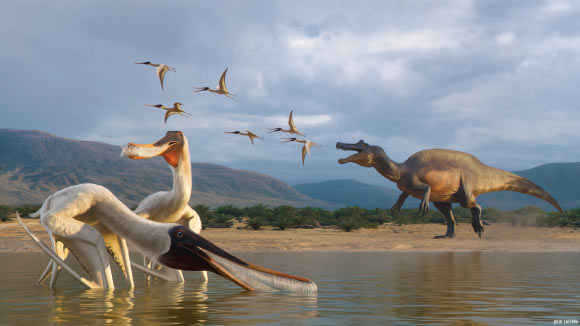Named Bakiribu waridza, the newly-identified species is the first filter-feeding pterosaur from the tropics.

Artistic reconstruction of the filter-feeding pterosaur Barikibu waridza in the Early Cretaceous Romualdo Formation environment; the spinosaurid dinosaur in the background represents the putative predator that hunted Barikibu waridza. Image credit: Julio Lacerda.
Bakiribu waridza lived in the tropical latitudes of the supercontinent Gondwana during the Early Cretaceous, approximately 113 million years ago.
The ancient flying reptile belongs to Pterodaustrini, a group of pterosaurs within the clade Ctenochasmatidae.
“Ctenochasmatidae is a clade of pterodactyloid pterosaurs, which thrived during the Late Jurassic and Early Cretaceous,” said Dr. Aline Ghilardi from the Universidade Federal do Rio Grande do Norte and colleagues.
“Recent discoveries have shed light on the diversity and ecological adaptations of this group, particularly through the examination of new fossil specimens from various geographic regions and geological periods.”
“These pterosaurs exhibit a remarkable evolutionary trajectory, characterized by diverse morphological adaptations and a broad geographical distribution.”
“Recent discoveries from China, South America, and Europe have significantly enhanced our understanding of their ecology and highlighted the dynamic evolutionary history of this lineage.”
“Ctenochasmatids thrived mostly from the Late Jurassic to the Barremian but declined progressively towards the Late Early Cretaceous,” they added.
“Little is known about the later species and how the lineages moved and diversified between Laurasia and Gondwana.”
According to the researchers, Bakiribu waridza had extremely elongated jaws and dense, brush-like tooth rows, similar to the ctenochasmatine pterosaur Pterodaustro but distinct in tooth cross-section and spacing.
“Within Ctenochasmatidae, the subclade Ctenochasmatinae is distinguished by elongated snouts and numerous fine teeth, adaptations associated with their unique feeding strategies,” they said.
“The evolutionary trajectory of this group has been illuminated by discoveries such as Liaodactylus primus, from the Upper Jurassic of western Liaoning, China, which demonstrates a notable ecological transition from fish-catching to filter-feeding within the clade.”
“An extreme morphology can be found in Pterodaustro guinazui, which exhibits a thousand hyper-elongated baleen-like teeth on the lower jaw.”
“The extreme morphology of Pterodaustro indicates a hyper-specialization towards filter-feeding.”
The fossilized remains of two Bakiribu waridza individuals were found one part and its counterpart of a calcareous concretion from the Romualdo Formation in Brazil’s Araripe Basin.
The concretion also contained four fossil fish, likely the Early Cretaceous bony fish Tharrhias.
“The pterosaurs and fish were preserved within a wackestone concretion rich in non-oriented ostracodes and foraminifera, similar to other Romualdo Formation concretions,” the scientists said.
“The co-occurrence of densely packed, semi-articulated, and fragmented pterosaur bones (predominantly aligned in subparallel orientation) together with a cluster of similarly aligned fish supports the interpretation of the assemblage as a regurgitalite, a mass of indigestible material expelled orally by a predator.”
Bakiribu waridza had a mosaic of traits shared with both South American and European relatives.
“Its unique combination of anatomical traits — particularly its very elongated jaws, dense dentition with long and slender teeth, subquadrangular crowns in cross-section, and acrodont-like tooth implantation in both jaws — sheds new light on the evolutionary trajectory of filter-feeding pterosaurs,” the authors said.
“The exceptional preservation of the specimen within a regurgitalite, alongside head-aligned fish remains, provides rare direct evidence of trophic interactions in the Early Cretaceous Araripe paleoecosystem.”
“This discovery not only fills a paleobiogeographic gap in the distribution of Ctenochasmatinae but also underscores the significance of understudied, long-held museum specimens for revealing key evolutionary and paleoecological insights.”
“Bakiribu adds to the growing evidence that the Araripe Basin serves as a critical window into Early Cretaceous biodiversity, ecological complexity, and continental-scale faunal exchanges.”
The team’s paper was published on November 10, 2025 in the journal Scientific Reports.
_____
R.V. Pêgas et al. 2025. A regurgitalite reveals a new filter-feeding pterosaur from the Santana Group. Sci Rep 15, 37336; doi: 10.1038/s41598-025-22983-3







